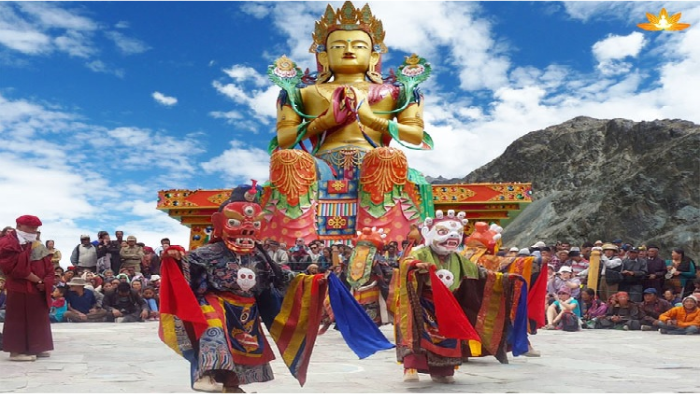Interview by Smt Swetha Raghunathan. Swetha is the author of 15 books. She has studied storytelling at Kathalaya. She has completed her MA in Writing from the University of Warwick. She has been a recipient of the Charles Wallace India Trust Award and The Times and Scottish Book Trust Jura New Writer Award.
The monsoon season, when the rains hit the parched earth, is considered by many cultures to be a gateway to the heavens and the point when earth turns into a haven and heaven. Human life depends on the rains and thus all cultures celebrate its arrival with jubilation. Because the rains colour the earth with fresh vegetation, monsoon festivals are usually very colourful. In this series on the Monsoon, Indica Soft Power investigates how this season of fertility, colour and renewal is celebrated in Ladakh.
The monsoon season in Ladakh starts in July and goes on till September. This time is considered by some to be ideal to visit Ladakh. The reason behind this is that there are several famous festivals in Ladakh during the monsoon season including the Hemis Festival. The Hemis Festival in 2022 was on the 9th and 10th of July - just at the commencement of the monsoon season.
Benoy K. Behl, eminent documentary filmmaker, art historian and photographer talks to Indica Soft Power about the Hemis Festival and Guru Padmasambhava whose birthday the festival is also a celebration of.
Could you tell us about the Hemis Festival?
The Hemis monastery about 32 kms South of Leh in Ladakh celebrates the birthday of the great Guru Padmasambhava. The Lamas celebrate with two days of the Cham, the monastic dance of the Lamas. The dance celebrates the victory of good over evil, it celebrates the achievements and the magic of guru Padmasambhava. We see him in his 8 different manifestations as he subdues evil, the evil which had haunted the minds of the people of Tibet.
Can you speak about Guru Padmasambhava and his contribution to Buddhism?
In the 4th century, in the region of Kashmir, Asanga and Vasubandhu developed the Yogachara school of Buddhism, which was to travel far and wide. In the 8th century, Guru Padmasambhava who was teaching in Kashmir, took a highly developed form of this Buddhism (now Vajrayana) and its sacred dance to Ladakh, Lahaul-Spiti, Kinnaur, Western Tibet, Sikkim, Bhutan and Arunachal Pradesh.
In the 8th century, Shantarakshita of Nalanda University was in Lhasa in Tibet. He had been invited to teach Buddhism. There Shantarakshita founded the first monastery of Tibet. It was called Samye and was based upon the Udantpuri Mahavihara in Bihar. However, Shantarakshita found that the people of Tibet were not converting to Buddhism. They remained afraid of the evil spirits which they feared inhabited the mountain passes and winds. They prayed to these evil spirits to appease them and would not convert to Buddhism.

Shantarakshita asked the king to invite Guru Padmasambhava to come to Tibet. He felt that he was the one Buddhist teacher who could establish Buddhism in the mountainous regions.
Guru Padmasambhava was also of the Nalanda University. At this time he was teaching in Kashmir. It was here in Kashmir, at sites like Parihaspura, that Vajrayana Buddhism or Tantric Buddhism developed to its fullest heights. It was this advanced form of Vajrayana Buddhism that the great Guru brought from Kashmir to Ladakh, Spiti, Kinnaur and Tibet.
Guru Padmasambhava, known as the Second Buddha, established Buddhism across the Himalayas and Trans-Himalayas. His is one of the greatest true stories of the world. It is also the story of one of the most powerful personalities of world history. Guru Padmasambhava, with his “magic” and colourful masked dances, dominated the Roof of the World in his time.
In all the world, the spectacle of nature is at its grandest and most awe-inspiring in the Trans-Himalayan Plateau. Here, on the roof of the world, man lives in the constant presence of great forces of nature, surrounded by the tallest mountains of the world. To this entire region Guru Padmasambhava bestowed a Buddhist culture, which continues till today. He is one of the most fascinating personalities in all of the history of the world. The man who is still worshipped across this entire region as the Second Buddha.
His is a story about one of the great miracles in human history, when he, in the power and majesty of his mission, travelled across the highest mountains. He travelled over 2,000 kilometres of inhospitable, high-altitude desert, to spread the message of the Buddha. These are regions where oxygen is scarce in the thin air and often it is difficult to breathe. Mountains reach for the skies and even the hundreds of passes he would have had to cross, are often higher than 15,000 feet altitude.
The great Guru not only crossed these lofty mountains and barren stretches of icy desert, he transformed the people across all these lands. Owing to him, the men and women here remain Buddhist till today.
In Indic philosophy, knowledge has to be experiential, rooted in one’s own personal self. In other words, the truth may always remain the same, but it has to be re-lived by each person. Padmasambhava’s obvious, very personal experience of the truth, would have been the reason for his success. That is why he would have earned the title of the Great Guru, Guru Rinpoche.




